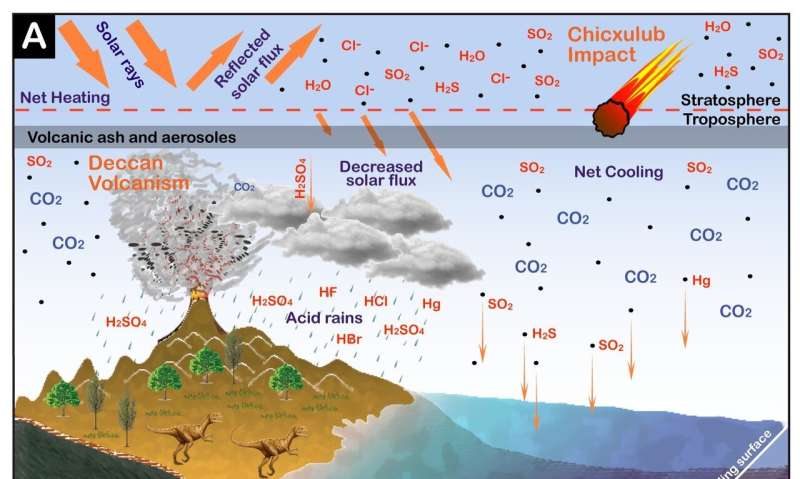Tale of two climate crises gives clues to the present

Figuring out what lies ahead for our species and our planet is one of the most pressing and challenging tasks for climate scientists. While models are very useful, there is nothing quite like Earth's history to reveal details about how oceans, animals, and plants respond to and recover from a warming world.
The two most recent major global warming events are especially instructive—and worrisome, say scientists presenting new research Wednesday at the Annual Meeting of the Geological Society of America.
Ancient analogs
The two past climate crises that are comparable to today's happened 56 and 66 million years ago. The earlier one, the Cretaceous-Paleogene boundary (KPB) mass extinction, is infamous for ending the reign of the dinosaurs. The later event, called the Paleocene-Eocene Thermal Maximum (PETM) was relatively less severe, and provides clues to how the world can recover from such difficult times.
"We chose these two because they are the most recent examples of rapid climate warming and have been widely studied so we have more information about them," said Paula Mateo, a geologist at Caltech, who will be presenting the study on Wednesday.
Both ancient global warming events were, like today, caused by the release of greenhouse gases—a.k.a. carbon emissions—into the atmosphere. The sources in the past were not fossil fuel burning however, but related to very large and long volcanic eruptions—unlike any that have occurred during the time humans have existed.
The geologic evidence suggests that the carbon emissions that preceded the dinosaurs' demise were at an average rate of about 0.2 to 3 gigatons per year. The PETM recorded carbon emissions of less than 1.1 gigatons per year, Mateo said. Those numbers are dwarfed next to humanity's emission rate of 10 gigatons per year, she added.
Dino killer?
The KPB mass extinction event is often attributed solely to the Chicxulub meteor impact in Mexico, but there is a growing body of evidence suggesting that the massive eruption of the Deccan Traps in India also played a role. That mega-eruption flowed across India in pulse after pulse, lasting about 750,000 years. A full 280,000 years before the extinction event the oceans had warmed 3 to 4 degrees Celsius while on land the warming was of 6 to 8 degrees C because of the eruptions. Volcanic activity accelerated during the last 25,000 years before the mass extinction, Mateo said, steadily releasing more carbon dioxide into the atmosphere. Those pulses added another 2.5 degrees C to the global temperature.
"This series of mega-pulses didn't let the ecosystems adapt or even survive," Mateo said. Fossil evidence suggests that the warming and ocean acidification stressed life on land and oceans, eventually contributing to one of the five mass extinction events in the history of the planet. Microfossils of the oceans' foraminifers, which are part of the base of the marine food chain, show signs that they were struggling leading up the end of the Cretaceous period and then 66% went extinct at the KPB, 33% survived but rapidly disappeared during the first 100,000 years after the KPB, and only one species survived in the long term. On land warming during the last 280,000 years of the Cretaceous appears to have started a decline in dinosaurs as well in early mammals, insects, and amphibians well prior to the last mega-eruptions ending with the KPB mass extinction.
Ocean-building event
The more recent PETM, for its part, was caused by the expansion of the North Atlantic Ocean basin. That involved a lot of magma rising up from below to become the new ocean crust. All that magma released a lot of carbon dioxide, which appears to have caused moderate warming that, in turn, triggered the melting of clathrates—frozen methane hydrate deposits in the ocean floor. The methane emissions supercharged the greenhouse situation and led to a 5 degree C spike of warming.
That warming was hard on living things on land and sea, but it wasn't a series of blows, like what led to the KPB. Many animals were able to adapt or migrate and avoid the harshest conditions. It was a single blow with environmental consequences that lasted about 200,000 years but there wasn't a mass extinction event.
The best analog
Listed side-by-side, it's sobering to see how many of the same ecosystem effects of the KPB and PETM are now being played out in the oceans and on land in real time as a result of anthropogenic warming.
"The difference with today is that even though it's a very short pulse, the rate of change is very, very rapid," said Mateo. "It's happening so fast that the ecosystems are unable to catch up. There is no time for adaptation."
So while today's greenhouse warming is a single pulse, as in the PETM, it is happening orders of magnitude faster, which could be creating effects more like those of the KPB.
Neither of the past events is a perfect analog, but they are instructive. The PETM could be an analogy for our best case scenario, Mateo explained. It's something humanity could potentially survive. The KPB, on the other hand, would be our worst case scenario analogy. If we take that path it would qualify as the sixth mass extinction in the planet's history.
More information: Paper No. 247-13: Mass Extinctions and Climate Change: Analogs of Today's Rapid Climate Warming and Potential Biotic Catastrophe: gsa.confex.com/gsa/2019AM/meet … app.cgi/Paper/334464
Provided by Geological Society of America




















